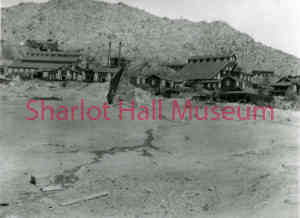Congress Mine Outbuildings
details
Unknown Unknown 1600.0481.0003.jpg M - 481 B&W 1600-0481-0003 m481pc Print 3x5 Historic Photographs c. 1917 Reproduction requires permission. Digital images property of SHM Library & ArchivesDescription
Congress Mine, Date Creek, Martinez Mining District, Yavapai County, Arizona.
Handwriting on back of old 3x5 photograph states: "Diamond" Joe Reynolds, owner. F. M. Murphy, Supt., bought the Congress for Diamond Joe. Took some 8 million in gold before it got too deep & hot to work. These two make a wonderful story!"
Frank M. Murphy (b. 1855 – d. 1917) was a local banker, mining magnate, and entrepreneur who is best remembered for his part in building the territory's railroad system which benefitted the mining industry. He also constructed and donated the 200 acre Murphy Park Zoo to the city of Prescott on December 25, 1909. The City turned him down, and it no longer exists.
Joseph Reynolds, known by the nickname of “Diamond Joe,” was a Minnesota steamboat owner and millionaire. An article in the September I, 1936 of the Prescott Evening Courier claimed that his nickname stemmed “not from the diamonds he wore but form the peculiarly schaped (sic) diamond that showed when he walked. He was partially bowlegged.” In the Midwest, he owned the Diamond Joe line of steamers, a railroad, and a number of mines in Arkansas. His Mississippi steamboats were considered “floating palaces.” It was he, who in 1889 instigated the building of a railroad to carry freight and passengers from Prescott to Phoenix.
The Congress mine, also nicknamed “Queen of the Hills,” became for a time one of Arizona's largest gold producers. Murphy and Reynolds paid $39,000 for the mining property which was 65 miles northwest of Prescott and any railroad. Reynolds died in February, 1890, in a little shanty, a bunkhouse, on the Congress mine property. After he died, the mine was sold for $1,500,000.
At one time, then President McKinley visited the Congress mine and was taken 1000 feet underground to view the inner-workings. An article in the December 22, 1897 edition of the Arizona Weekly Journal Miner boasted: “A visit to the Congress Mine would convince the most skeptical of the mineral resources of the southern part of the county. The pay roll at Congress embodies 425 men and this number is regularly employed. The present mines have plenty of gold in sight…” A population of 2000 supported a number of saloons, stores, theatres, schools and professional offices.
By 1902, the area's mining operations consisted of two 40-stamp mills, large roasting furnaces, and a cyanide plant that produced concentrates that were sent to distant smelters. During the 1950’s, after the mine shut down, the town didn't last long and the post office was moved to the railroad hub at Congress Junction. Leasers perodically worked the many tailings for the next thirty years. Scant traces of wooden buildings, foundations and numerous huge white and pink tailings' dumps remain. Today, the town known as "Congress" is actually old Congress Junction, and little remains of the original town site.
Purchase
To purchase this image please click on the NOTIFY US button and we will contact you with details
The process for online purchase of usage rights to this digital image is under development. To order this image, CLICK HERE to send an email request for details. Refer to the ‘Usage Terms & Conditions’ page for specific information. A signed “Permission for Use” contract must be completed and returned. Written permission from Sharlot Hall Museum is required to publish, display, or reproduce in any form whatsoever, including all types of electronic media including, but not limited to online sources, websites, Facebook Twitter, or eBooks. Digital files of images, text, sound or audio/visual recordings, or moving images remain the property of Sharlot Hall Museum, and may not be copied, modified, redistributed, resold nor deposited with another institution. Sharlot Hall Museum reserves the right to refuse reproduction of any of its materials, and to impose such conditions as it may deem appropriate. For certain scenarios, the price for personal usage of the digital content is minimal; CLICK HERE to download the specific form for personal usage. For additional information, contact the Museum Library & Archives at 928-445-3122 ext. 14 or email: orderdesk@sharlot.org.




